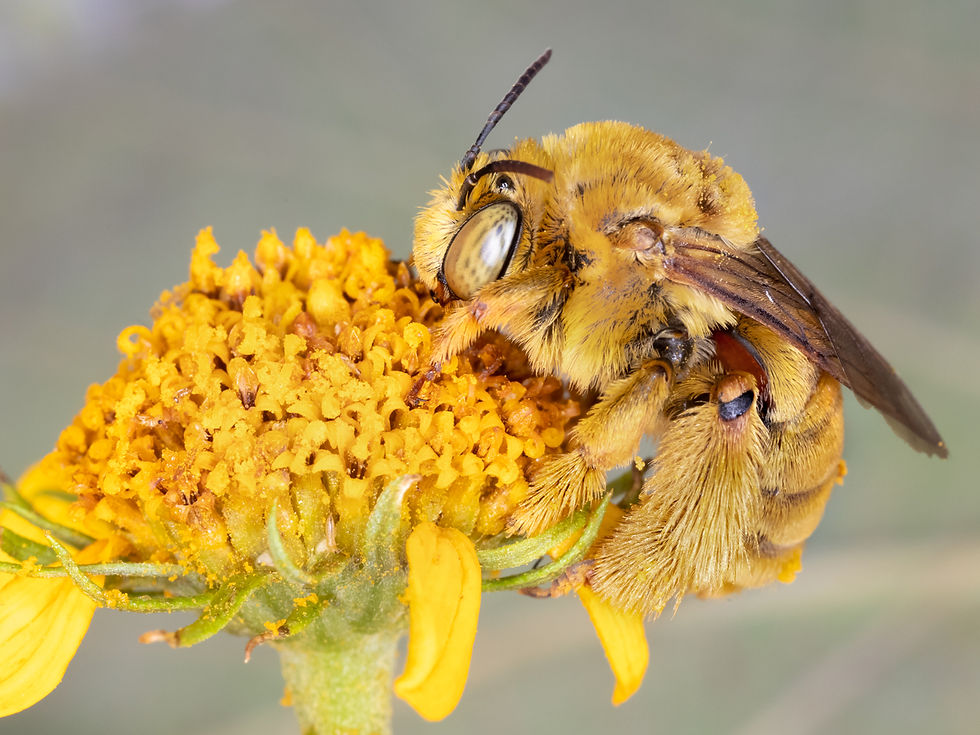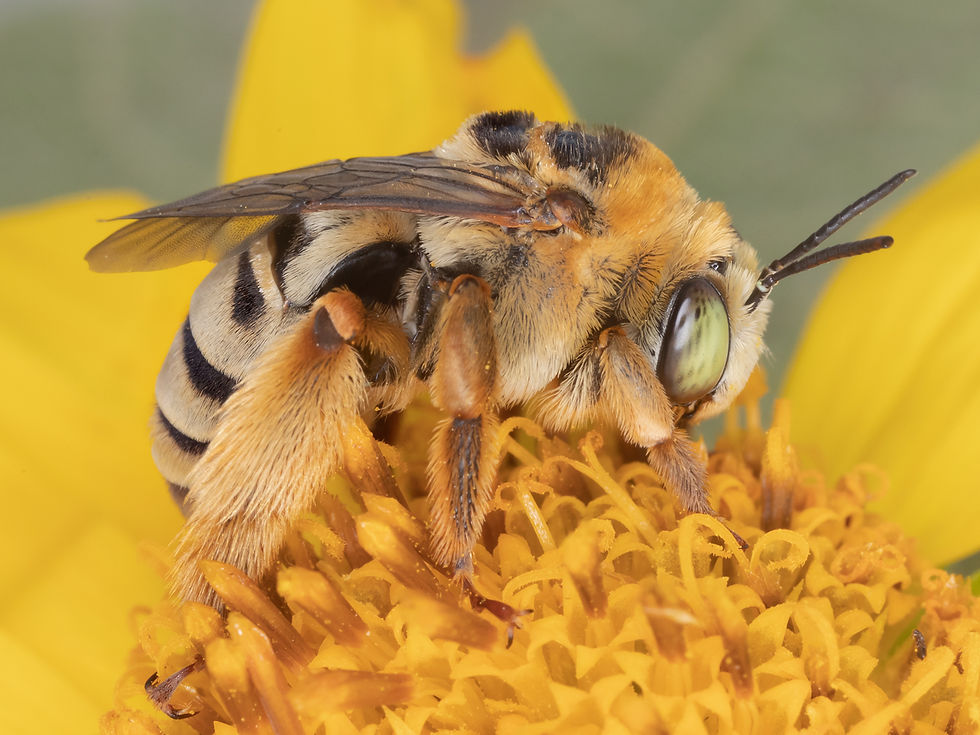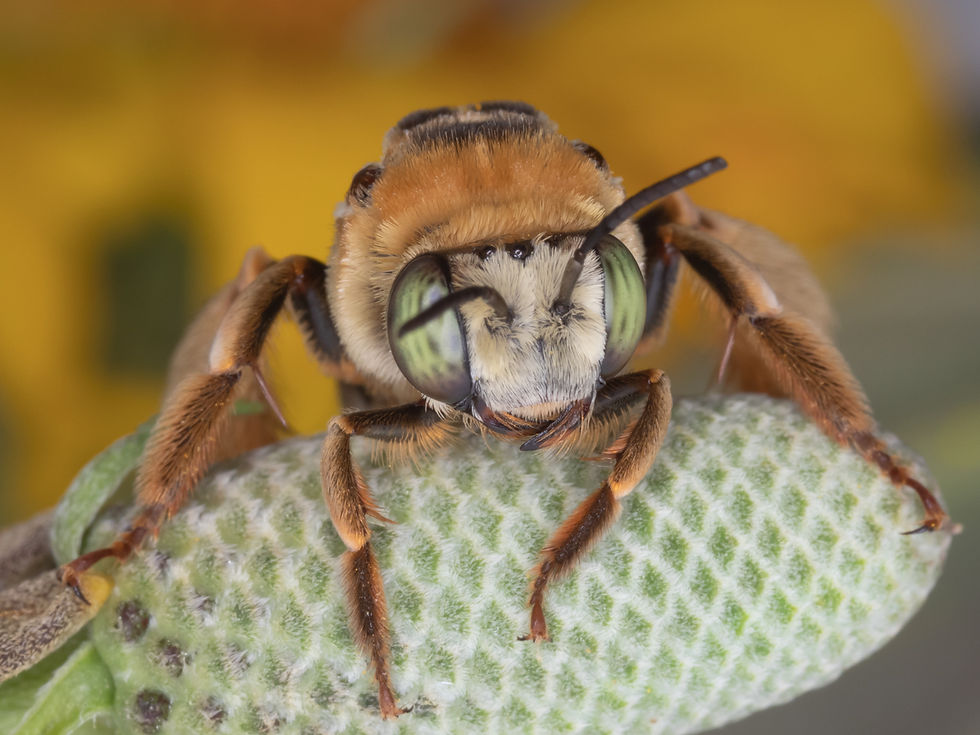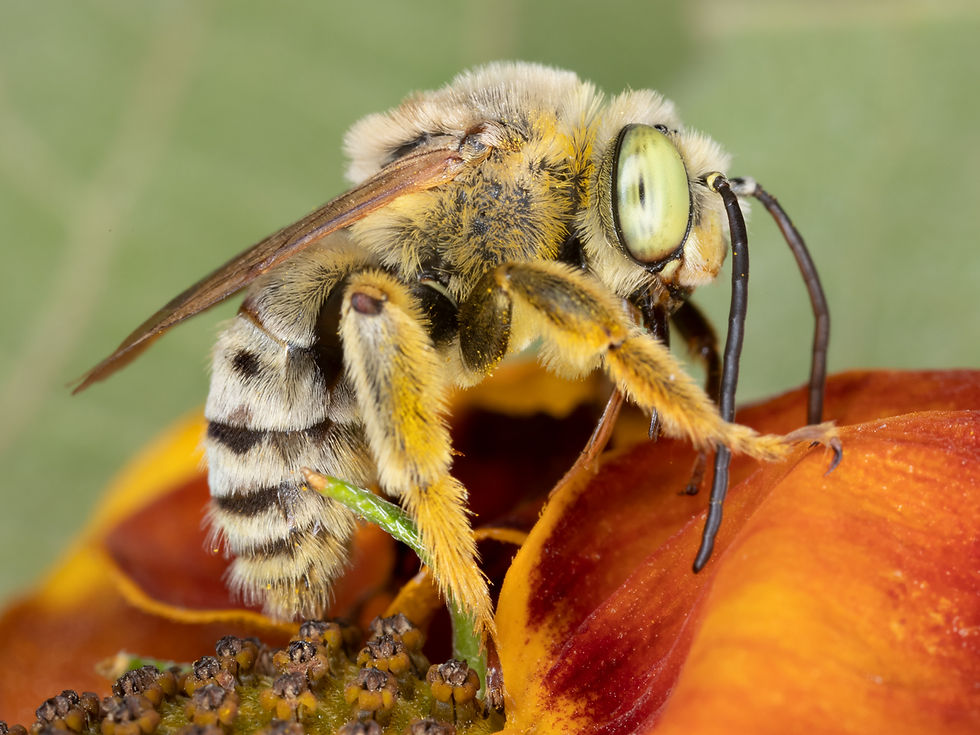SHARP-EATMAN
NATURE
PHOTOGRAPHY
ID GUIDE TO WILD BEES
OF THE NATIONAL BUTTERFLY CENTER
Mission, Texas
SVASTRA LONG-HORNED BEES
Svastra / Epimelissodes
SVASTRA LONG-HORNED BEES
Svastra

EPIMELISSODES & SVASTRA LONG-HORNED BEES
Epimelisodes / Svastra
EPIMELISSODES or SVASTRA LONG-HORNED BEES
Genus Epimelissodes - Formerly called Svastra
Until recently, the Epimelissodes long-horned bees appearing on this page were known as Svastra.
The genus Svastra was first documented by the Argentinean naturalist Eduardo Ladislao Holmberg, a prolific science writer, author of science fiction and director of the Buenos Aires Zoological Gardens.
In the late 1800’s and early 1900’s, Holmberg, at times forsaking his longstanding interest in spiders, undertook a series of bee-collecting expeditions into the mountains of Argentina and the wilds of neighboring South American nations. He encountered diverse longhorn bee species and named the genus Svastra (Sanskrit for “sister”), remarking on its similarity to its sister genus Melissoptila, which he too had named.
For most of its history, the genus Svastra was thought to range from southern Canada through Mexico and into temperate South America. However, new phylogenetic studies clarifying the evolutionary history of various long-horned bee genera have resulted in the reclassification of North American Svastra. They have now been reassigned to their own genus: Epimelissodes.
Nonetheless, Svastra and Epimelissodes continue to share characteristics that aid in their identification.
Characteristics of Svastra and Epimelissodes.
Svastra and Epimelissodes are generally husky bees, with hairy thoraxes, faces and legs. The bees' abdomens are often banded by dark-and-pale hairs or, less commonly, covered with short golden hairs or dark hair. The female has a dark clypeus (the face-part above the mandibles), while the male has a yellow clypeus, clearly visible to the naked eye.
Svastra and Epimelissodes are differentiated from Melissoptila, Melissodes and other long-horned bee genera in part by size. In Bees of the Eastern United States, T.B. Mitchell described Svastra generally as robustly built, noting that some of them were nearly as large as queen bumble bees (measuring up to 20 mm or 3/4 inches).
Three of the Epimelissodes species on this page are notably large for laong-horned bees: Sabine's long-horned bee (Epimelissodes sabinensis), the frisky long-horned bee (Epimelissodes petulca) and the black-legged long-horned bee (Epimelissodes atripes). In the field, these bees' hefty size and robust build make them easily recognizable as Epimelissodes.
Other general traits aid in identifying regional Epimeliissodes. The antennae of males are relatively short for long-horned bees, ordinarily reaching no farther than the first segment of the bee’s abdomen. Mitchell wrote that Svastra females could be best distinguished from other long-horned bee genera by a single trait, visible to the naked eye: females have a tuft of long hairs in the middle of the metanotum (located near the back of the thorax). This trait, shared by North American Epimelissodes, is shown in the accompanying photo strip.
Bee behavior and pollination practices
Like most long-horned bees, Svastra and Epimelissodes nest in the ground. They are typically solitary, but sometimes build nests close to one another in large groups. Epimelissodes sabinensis females also are known to share nests with one another: each bee provisions her own egg chambers with food stores for her offspring, while jointly excavating tunnels and nest entrances with other Epimelissodes.
Epimelissodes are best known for their prowess as sunflower pollinators. Most Epimelissodes of the Lower RIo Grande Valley forage principally on aster-family plants. Among these are the Sabine's long-horned bee (Epimelissodes sabinensis), the frisky long-horned bee (Epimelissodes petulca) and the Texas long-horned bee (Epimelissodes texana).
The black-legged long-horned bee (Epimelissodes atripes) is a vibratile (“buzz”) pollinator, unlike the many Epimelissodes that are Asteraceae specialists. Epimelissodes atripes is known to visit a range of flora. In the Valley it is often associated with shrubby blue salvia (Salvia ballotiflora), a plant in the mint family.
A few Epimelissodes species are specialist pollinators of cactus. Among these is the barrel cactus long-horned bee Epimelissodes duplocincta). This is the sole Epimelissodes that belongs to the subgenus Idiomelissodes.

A female Epimelissodes sabinensis
TRAITS OF EPIMELISSODES

Epimelissodes generally look "furry" - hairs densely cover their heads, bodies and legs.

Epimelissodes have robust builds. Their heads and thoraxes are often covered with pale or golden hairs. The hairs on their legs vary in color: some have black leg hairs, like the female bee shown here.

More often, the legs of Epimelissodes sport blond or golden hairs, while their bodies are covered with a mixture of light and dark hairs.

Some Epimelissodes are entirely covered with pale or golden hair.

Female Epimelissodes have bushy scopal hairs on their hind legs.

Here is a close-up of the feathery pollen-collecting (scopal) hairs on the hind leg of a female Epimelissodes.
TAXONOMY OF EPIMELISSODES
Order: Hymenoptera
Family: Apidae
Subfamily: Eucerinae
Tribe: Eucerini
Genus: Epimelissodes (formerly Svastra)
Species shown below:
Epimelissodes (Epimelissodes) atripes (Black-legged long-horned bee)
Epimelissodes (Epimelissodes) petulca (Frisky long-horned bee)
Epimelissodes (Epimelissodes) sabinensis (Sabine long-horned bee)
Epimelissodes ( (Epimelissodes) texana (Texas long-horned bee)
Epimelissodes (Idiomelissodes) duplocincta (Barrel cactus long-horned bee)
A note regarding the renaming of North American Svastra: A recent analysis by Freitas et al (2023) places North American species of Svastra in the genus Epimelissodes.
Recommended reading:
Freitas FV, Branstetter MG, Franceschini-Santos VH, Dorchin A, Wright KW, López-Uribe MM, Griswold TL, Silveira FA, Almeida EAB. 2023. UCE phylogenomics, biogeography, and classification of long-horned bees (Hymenoptera: Apidae: Eucerinae), with insights on using specimens with extremely degraded DNA. Insect Systematics and Diversity 7(4), 3: 1-21.
Dorchin A, López-Uribe MM, Praz CJ, Griswold TL, Danforth BN. 2018. Phylogeny, new generic-level classification, and historical biogeography of the Eucera complex (Hymenoptera: Apidae). Molecular Phylogenetics and Evolution 119:81–92.
Epimelissodes Species of the National Butterfly Center
Frisky long-horned bee
Epimelissodes (Epimelissodes) petulca
formerly Svastra (Epimelissodes) petulca
Family: Apidae
Size: 16 mm (female); 14 mm (male)
Associated flora at NBC:
Blanketflower
(Gaillardia pulchella)
Cowpen Daisy
(Verbesina encelioides)
Mexican hat
(Ratibida columnifera)
Common sunflower
(Helianthus annuus)
Plant Family: Asteraceae
When and where seen:
April through November
Common in Cameron, Hidalgo
and Starr Counties

A female Epimelissodes petulca: females of this species are large, robust bees with bushy pale or orangish scopal hairs on their hind legs. Their abdomens are banded with pale hairs.

Dorsal view of female bee: the female's thorax is rimmmed with orange hairs. Although the scutum and scutellum look bald, they are in fact partly covered with black hairs.

Female Epimelissodes petulca have dark faces covered with pale hairs, and dark mandibles.

A female Epimelissodes petulca

A female Epimelissodes petulca shown from above

A male Epimelissodes petulca

A male Epimelissodes petulca -- note the bushy pale hairs on the bee's face.

The male bee has bright green eyes and a yellow clypeus. The base of each mandible is also pale yellow.
The frisky long-horned bee is the most common member of the genus Epimelissodes in the Lower Rio Grande Valley. It emerges in mid-spring and remains flying through late fall. It is most likely to be found on large-flowered members of the aster family -- including, for example, cowpen daisy, gaillardia and sunflowers. Epimelissodes petulca is the only large bee at NBC that feeds on Mexican hat, a composite flower whose odd shape -- a tall brown column skirted by short orange petals -- makes an awkward landing pad for most big bees.
Black-legged long-horned bee
Epimelissodes (Epimelissodes) atripes
formerly Svastra (Epimelissodes) atripes
Family: Apidae
Size: 13-19 mm (females)
15-18 mm (males)
Associated flora:
Shruby blue salvia
Salvia balllotiflora
Family: Laminaceae
Cowpen daisy
Verbesina enceloides
Family: Asteraceae
When and where seen:
June 16-21, 2021
Puerto Rico TX (Hidalgo Co.)
Rio Grande City TX (Starr Co.)

A female Epimelissodes atripes (dark morph)

A female Epimelissodes atripes: this is an unusual dark morph of this species. On the typical female Epimelissodes atripes, the lower half of the thorax is covered with blond hairs, rather than black hairs.

Dorsal view of female's thorax

The legs of Epimelissodes atripes females are covered with bushy black hairs.

A male Epimelissodes atripes

The bee's thorax is covered with pale-brown hairs, its abdomen is banded by black and pale hairs, and its legs are covered with dense black hairs.

Dorsal view of thorax & vertex: note that the male's scutellum is fringed with a semi-circle of pale rust-brown hairs.

A male Epimelissodes atripes
Epimelissodes atripes is easily distinguished from other Epimelissodes of the Valley by the predominantly black hairs covering its hind legs and abdomen.
The black-legged long-horned bee is uncommon in the Valley, but it has been documented in all three of its border counties. Epimelissodes atripes has several subspecies variations. The female dark morph variation featured here is quite unusual. It appeared in mid-June in northwest Hidalgo County. It differs from the typical Epimelissodes atripes in having dark hair covering the lower half of its thorax and in having minimal white hairs on its abdomen.
The male bee shown here has more typical hair coloration for the species. It appeared in Starr County in late June 2021, buzzing around devil’s claw (Proboscidea louisianica).
Sabine long-horned bee
Epimelissodes (Epimelissodes) sabinensis
formerly Svastra (Epimelissodes) sabinensis
Family: Apidae
Size: 14 mm (female and male)
Food plants at NBC:
Skeleton-leaf goldeneye
(Viguiera stenoloba)
Cowpen daisy
(Verbesina encelioides)
Plant Family: Asteraceae
Catclaw acacia (males)
(Senagalia greggi)
Plant Family: Fabaceae
When and where seen:
November 15, 2018
National Butterfly Center
June 18, 2021
Campos Viejos Ranch
Rio Grande City (Starr Co.)
April 16, 2023.
Dos Vendadas Ranch
Rio Grande City (Starr Co.)

A female Epimelissodes sabinensis feeding on skeleton-leaf golden-eye

A female Epimelissodes sabinensis: these impressive bees look like small lions. They have golden hairs on their thoraxes, abdomens and legs.

A female Epimelissodes sabinensis

A male Epimelissodes sabinensis

A male Epimelissodes sabinensis

The male bee has a yellow clypeus and mandibles that are yellow at the base. Its antennae are longer than the female's and darkly-colored. Note the male's reddish lower legs.
Epimelissodes sabinensis is a magnificent long-horned bee, large and leonine and covered with golden hair. Copious pale and golden hairs cover the bees' heads and thoraxes, and their abdomens are clothed with short, tawny hairs. The eyes of both males and females are green.
Within Texas, Epimelissodes sabinensis is fairly easily differentiated from other Epimelissodes. Other documented Texas Epimelissodes species include Epimelissodes aegis, E. atripes, E. compta, E. machaerantherae, S. obliqua, E. petulca and E. texana. Unlike Epimelissodes sabinensis, all have black abdomens striped with some pale banding.
Epimelissodes sabinensis ranges west to California, north to Colorado and south into Mexico. This species is associated with aster-family flowers. Epimelissodes sabinensis is the host of the cuckoo bee Triepeolus penicilliferus.
Texas long-horned bee
Epimelissodes (Epimelissodes) texana
formerly Svastra (Epimelissodes) texana
Family: Apidae
Size: 13-14 mm (female)
Associated Plants in
Lower Rio Grande Valley:
Camphorweed
(Heterotheca subaxillaris)
When and where seen:
November 2022
Weslaco, TX (Hidalgo Co.)

A female Epimelissodes texana

A female Epimelissodes texana: note that the hair below the bee's tegula is entirely pale.

Dorsal view of female bee

Close-up showing dark hairs on scutum and scutellum, and light hairs on vertex and along the edges of the scutum

Face of female bee: the female has a black face, short, dark antennae and blue eyes.

A female Epimelissodes texana
Epimelissodes texana is uncommon in the Valley. This species runs smaller than similar regional Epimelissodes with banded abdomens, such as Epimelissodes petulca. Female Epimelissodes texana are best distinguished by their size and by traits of the pale hair bands on the bees' abdomens, as shown in the photo strip. Females have blue eyes, a trait that aids in distinguishing them in the field from Epimelissodes petulca females, which have green eyes. The Texas long-horned bee is associated with aster-family flowers.
Associated Flora
candy barrel cactus
(Ferocactus wislizeni)
Family: Cactaceae
When and where seen:
June 18, 2022
Rio Grande City (Starr Co.)
Barrel cactus long-horned bee
Epimelissodes (Idiomelissodes) duplocincta
formerly Svastra (Idiomelissodes) duplocincta
Family: Apidae
Size: 10 mm (female)
8-9 mm (male)

A female Epimelissodes duplocincta

A female Epimelissodes duplocincta

This is a distinctive bee with bold bands on its abdomen formed by alternating black and white hairs. (Females have five white bands and males six.)

Dorsal view of female bee: the bee’s head, thorax and legs are covered predominantly with white hairs, intermingled with some brown hairs. The bee’s wings are light brown with dark-brown veins, and its tegulae are reddish-gold.

Close-up of vertex & thorax: white, flattened hairs line the back of the scutellum, and form a tuft on the metanotum.

Rear view of a female barrel cactus long-horned bee
Epimelissodes duplocincta, the sole member of its subgenus Idiomelissodes, is the smallest of any of the Epimelissodes featured on this guide page. The barrel cactus longhorn is readily identified by the boldly-defined, broad white bands of hair on its abdomen. The rear band of both female and male bees also has a distinctive shape – it peaks in the middle like the roof of a pagoda (as shown in the accompanying photo strip).
This bee is most likely to appear in the Valley where barrel cactus abounds. Males often can be found in early morning on plants located near cacti, sleeping in aggregations, a practice which, according to a 1998 study by entomologist John Alcock, gives the small Epimelissodes some degree of protection against predatory assassin bugs. These aggregations are easily spotted, because of the bright banding on the male bees’ abdomens.
CITE THIS PAGE: Sharp, Paula and Ross Eatman. "Epimelissodes." Wild Bees of the National Butterfly Center of Mission, Texas. 15 Jan. 2019, http://www.wildbeestexas.com. Accessed [day/month/year guide accessed].